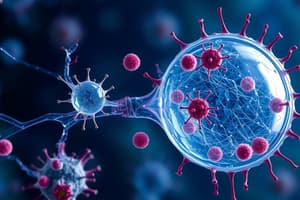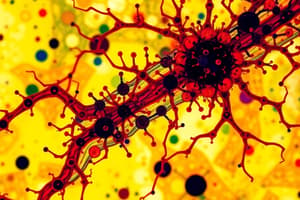Podcast
Questions and Answers
What method did John Tyndall develop for sterilization?
What method did John Tyndall develop for sterilization?
- Tyndallization (correct)
- Incineration
- Filtration
- Autoclaving
Which bacteria did Robert Koch discover that are known to cause diseases?
Which bacteria did Robert Koch discover that are known to cause diseases?
- Clostridium botulinum and Neisseria gonorrhoeae
- Escherichia coli and Salmonella
- Bacillus anthracis and Mycobacterium tuberculosis (correct)
- Staphylococcus aureus and Streptococcus pneumoniae
What did Ferdinand Cohn discover about certain bacteria?
What did Ferdinand Cohn discover about certain bacteria?
- They require aerobic conditions for growth
- They can survive in the absence of moisture
- They can withstand heating and boiling (correct)
- They can grow under extreme pH levels
Which of the following was a significant contribution of Robert Koch?
Which of the following was a significant contribution of Robert Koch?
How long does Tyndallization expose materials to 100˚C moist heat?
How long does Tyndallization expose materials to 100˚C moist heat?
Which postulate is associated with Robert Koch's germ theory of disease?
Which postulate is associated with Robert Koch's germ theory of disease?
Which of the following methods is NOT directly linked to the techniques of bacterial cultivation?
Which of the following methods is NOT directly linked to the techniques of bacterial cultivation?
What is the main goal of Tyndallization?
What is the main goal of Tyndallization?
Which of the following processes is associated with the categorization of organisms into taxonomic groups?
Which of the following processes is associated with the categorization of organisms into taxonomic groups?
What is the primary purpose of nomenclature in microbial taxonomy?
What is the primary purpose of nomenclature in microbial taxonomy?
Which is NOT a subgroup within a species in microbial taxonomy?
Which is NOT a subgroup within a species in microbial taxonomy?
What is the main goal of identification in microbial taxonomy?
What is the main goal of identification in microbial taxonomy?
In the context of microbial taxonomy, what does the abbreviation 'sp.' stand for?
In the context of microbial taxonomy, what does the abbreviation 'sp.' stand for?
What is a distinguishing feature of subspecies in microbial taxonomy?
What is a distinguishing feature of subspecies in microbial taxonomy?
What hypothesis did John Needham support based on his 1745 experiment?
What hypothesis did John Needham support based on his 1745 experiment?
How did Lazzaro Spallanzani's experiment in 1765 differ from John Needham's?
How did Lazzaro Spallanzani's experiment in 1765 differ from John Needham's?
Which statement aligns with Spallanzani's conclusion about microbes?
Which statement aligns with Spallanzani's conclusion about microbes?
What essential element did Needham overlook that influenced his experiment's outcomes?
What essential element did Needham overlook that influenced his experiment's outcomes?
What overall scientific principle can be drawn from the experiments of Needham and Spallanzani?
What overall scientific principle can be drawn from the experiments of Needham and Spallanzani?
Which of the following is a key element of Spallanzani's methodology?
Which of the following is a key element of Spallanzani's methodology?
What pivotal theory did both Needham and Spallanzani challenge or support with their experiments?
What pivotal theory did both Needham and Spallanzani challenge or support with their experiments?
What major advancement in scientific methodology was highlighted by Spallanzani’s experiment?
What major advancement in scientific methodology was highlighted by Spallanzani’s experiment?
Flashcards are hidden until you start studying
Study Notes
Theory of Biogenesis
- John Tyndall introduced tyndallization, a sterilization method in 1860.
- Tyndallization involves exposing materials to moist heat for three consecutive days at 100˚C for 30 minutes, effectively destroying bacterial spores.
Contributions of Ferdinand Cohn
- Ferdinand Cohn discovered certain bacteria could resist boiling, known as endospores.
Germ Theory of Disease
- Robert Koch formulated the germ theory of disease using Koch’s postulates to demonstrate that bacteria can cause disease.
- Notable discoveries include Bacillus anthracis (causes anthrax) and Mycobacterium tuberculosis (causes tuberculosis).
- Koch was the first to cultivate bacteria using boiled potatoes, gelatin, meat extracts, and proteins, leading to the development of a culture medium.
Spontaneous Generation Theory
- John Needham's experiment (1745) involved boiling mutton broth in a flask, which later became cloudy, supporting his claim that organic matter has a “vital force” to generate life.
Critical Revisions to Spontaneous Generation
- Lazzaro Spallanzani (1765) improved upon Needham's experiments by sealing broth in jars before boiling it, which contradicted Needham's conclusions.
- Spallanzani suggested that microbes entered from the air and could be eliminated through boiling.
Microbial Taxonomy
- Classification: Organisms are categorized into taxonomic groups based on biochemical, physiological, genetic, and morphological properties (using the DKPCOFGS hierarchy).
- Nomenclature: Involves naming organisms according to international rules based on their characteristics.
- Identification: Practical application of taxonomy to isolate, distinguish, and verify organisms, particularly in clinical settings for diagnosing diseases.
Taxonomic Groups
- Species is the most basic taxonomic group, denoted as "sp." (singular) or "spp." (plural), representing collections of bacterial strains.
- Subspecies refers to subdivisions within a species and includes:
- Biotype: Variants based on biochemical characteristics.
- Serotype: Variants based on serological properties.
- Genotype: Variants identified through genetic analysis.
Studying That Suits You
Use AI to generate personalized quizzes and flashcards to suit your learning preferences.




